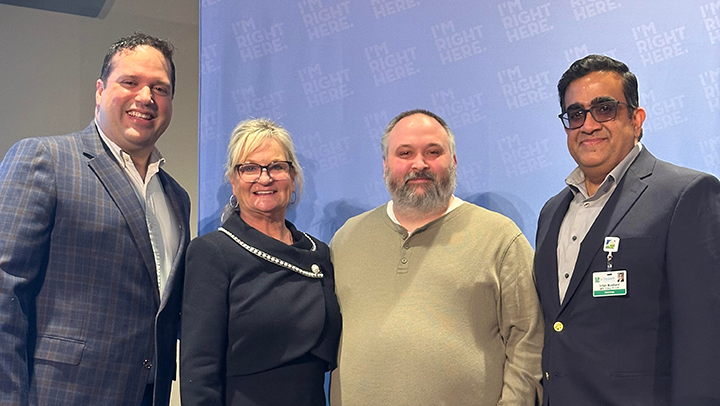There are times when it’s good to be first and times when, perhaps, you’d rather not be. Deep in the throes of the COVID-19 pandemic, Dustin Clark experienced both as the first ECMO patient treated at St. Elizabeth Healthcare.
ECMO — extracorporeal membrane oxygenation — is a technology that helped some of the nation’s sickest COVID-19 patients survive respiratory failure. It uses a machine to oxygenate blood, remove carbon dioxide outside the body and then return it with the aid of a pump. By taking over the lungs’ workload, it provides the lungs time to rest and heal. Similar treatment can help people with heart failure.
A Case of COVID
It was September 2, 2021, when Dustin arrived at St. Elizabeth Edgewood Hospital. For days, he and his wife had been battling COVID-19 at home. But when Dustin’s breathing became more labored and he could barely talk, his wife said he needed to see a doctor.
Dustin briefly passed out while stumbling to the car. But with his wife’s help, he got to an urgent care center, which directed him to the emergency department at St. Elizabeth. It was there that the gravity of the situation became clear.
“They wheeled me into the hospital and checked my oxygen level. It was 25,” Dustin recalls. “I’m like, is that bad? I don’t know.”
Given that normal oxygen saturation levels should be close to 100, it was.
The First ECMO Patient
Doctors first put Dustin on high-flow oxygen. But he remembers waking up in a panic, saying repeatedly, “I can’t breathe.”
That was Dustin’s last memory for days. Doctors placed him on a ventilator. But as his vital signs continued to go downhill, the team at St. Elizabeth knew he needed something more. ECMO was it.
At the time, St. Elizabeth was just establishing its ECMO program. Caroline Lindemann, RRT, was spearheading the efforts with Cardiothoracic Surgeon George Christensen, DO, who is now the program’s Medical Director.
In the pandemic’s earliest days, it wasn’t clear that ECMO helped COVID-19 patients, according to Dr. Christensen. But with Dustin’s condition deteriorating and few other treatment options, the team at St. Elizabeth made Dustin its first ECMO patient.
“His blood gases were profoundly low,” says Dr. Christensen. “There was some uncertainty, but at that time, we were seeing significant mortality.”
Beating the Odds
To begin ECMO, Dr. Christensen placed flexible tubes into two of Dustin’s veins to allow blood to flow to and from the ECMO machine and Dustin’s body. A variety of other experts then helped provide his care.
While ECMO did offer hope, Dustin’s outlook was bleak.
“They basically told my wife and mom that I had a 5% chance to live,” Dustin says.
But he did live. And about 12 days later, he woke up. The team weaned him off ECMO and, eventually, the ventilator and tracheostomy that allowed him to get oxygen through a hole in his neck. It was a challenge for Dustin, both physically and mentally. But he got through it.
“You go your whole life and breathing is not something you think about. You just do it,” Dustin says. “When I realized I needed to breathe to stay alive, I was scared to go off the ventilator because I didn’t know that I could do it myself.”
New Perspective and Hope for the Future
Following a stay at St. Elizabeth Ft. Thomas Hospital to get rid of his tracheostomy and a rehabilitation facility to rebuild his strength, Dustin returned home two months after first arriving at St. Elizabeth. He was on oxygen and used a walker at first. Dustin still gets winded sometimes, which, he says, might have more to do with his fitness level than COVID. But he’s doing well overall.
Certainly, his experience changed him. He thinks about his own mortality now. And he cherishes every moment he has with his wife and kids.
“I just want to spend as much time as I can appreciating the people around me and letting them know that I love them,” he says.
That appreciation extends to the team at St. Elizabeth, especially Lindemann.
“Caroline was amazing,” he says. “She made sure that my family was taken care of.”
Dustin is happy he was the first ECMO patient at St. Elizabeth. Like anyone, he would have preferred not to have needed it. But it helped save his life. And because he was first, the team gained confidence and other ECMO patients have followed.
“Hopefully, more lives are saved because I was the guinea pig,” he jokes.
Medical advancements in heart care mean better outcomes for patients. To learn more about the heart and vascular services offered at St. Elizabeth, visit our website.

